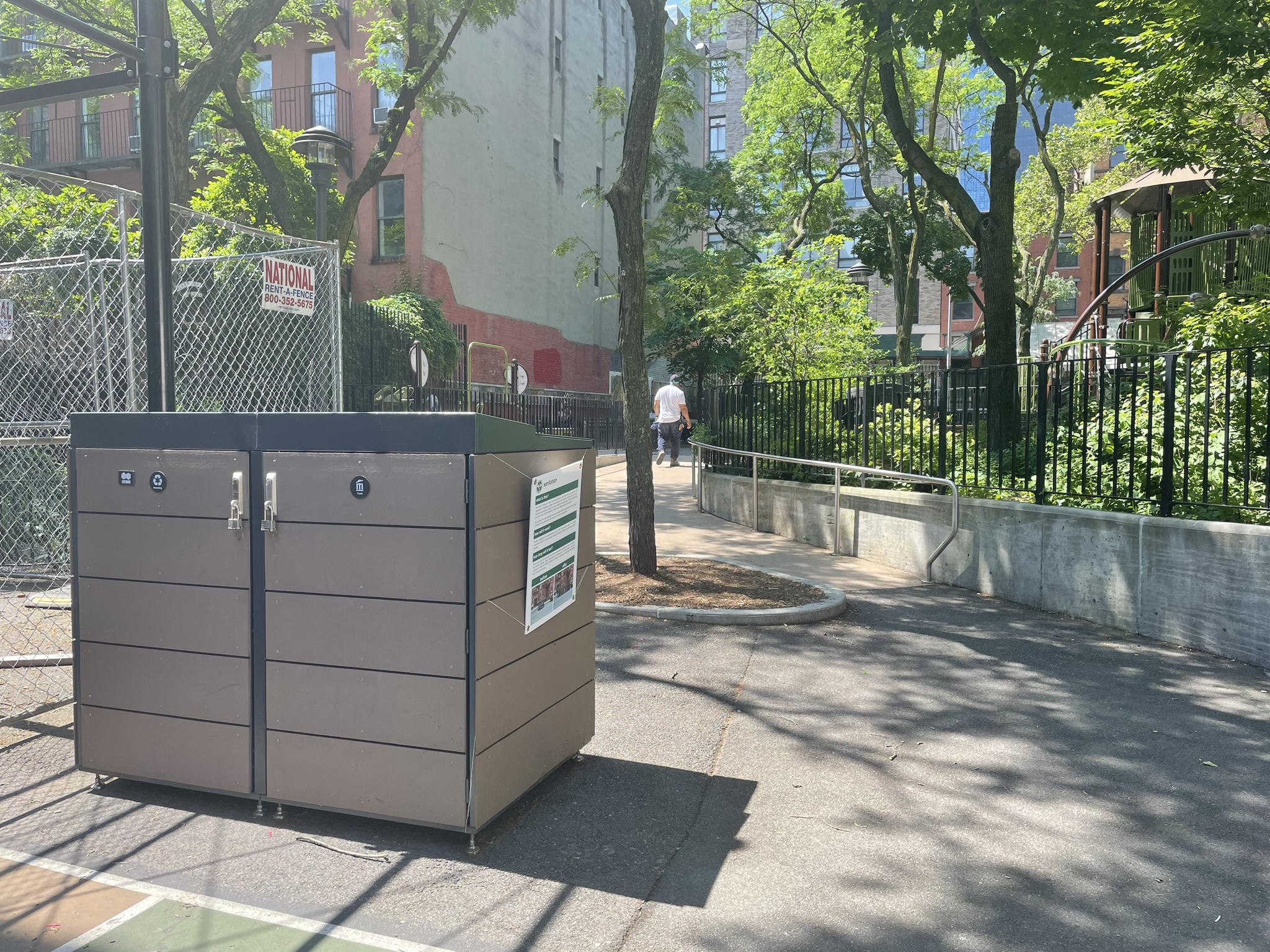Bin down so long it look like up to us!
The city's long-awaited Clean Curbs residential pilot, which will containerize the trash on one residential block, will launch this fall on W. 45th Street between Ninth and 10th avenues in Hells Kitchen, Streetsblog has learned.
Evidence of the pilot, which Sanitation Department announced in 2020, appeared recently in the form of a demonstration bin in Mathews-Palmer Playground, a quiet, mid block, vest-pocket park with basketball courts.
A sign on the bin explains that the Department of Sanitation is "testing a rat-proof trash container" and will be installing "several dozen" of the bins later this year for the use of "building managers and superintendents," who will store trash and recycling bags in them "instead of on the sidewalk."
Before-and-after renderings on the sign show bins positioned in the curbside street lane in what car drivers might consider "parking" spots.
Neighbors quizzed recently seemed cautiously optimistic, but were concerned by controversy from car drivers, who think of the curbside lane as their exclusive domain.
"I'll have to see it in action," said Jim Walton, a 43-year resident of the area. "It'll take up parking space, so it'll anger some people who park here.
"I hope it is effective," Walton continued. "Although right now it looks pretty good, but we might see trash on the curb out here. A good idea, and I hope it works. Let's see if people actually put trash in it."
Jiwon Kim, a sous chef at Kochi restaurant, around the corner on 10th Avenue, said the bin "makes sense" and "should help with rats," because it would be better to put the restaurant's trash "somewhere other than the street."
No parking is allowed on W. 45th street from 8 a.m. to 6 p.m. except on Sunday.
The area's Council member, Erik Bottcher, said he's “thrilled that our district was was the first to be chosen for this exciting advance in New York’s sanitation practices," adding, "Getting trash off our sidewalks is the future and this is another important step.”
The demonstration bin is the latest step in the city's small but important bid to put a dent in New York's famous "5 o'clock shadow" — the mountains of black trash bags that appear on sidewalks each collection day, leaking garbage, attracting rats and blocking the egress of pedestrians. In April, the city and the Times Square Alliance, a business improvement district, unveiled two such bins as the inaugural installment of the Clean Curbs commercial pilot, one in the street at the northwest corner of 43rd and Eighth Avenue and the other on the sidewalk at Seventh Avenue and 41st Street.
This month, as Streetsblog reported in April, Clean Curbs spread to Brooklyn, with a six-bin curbside trash corral installed by the Montague Street BID in front of City Chemist in Brooklyn Heights. DSNY has said that the $1.3-million program will be piloted in each of the five boroughs. On Monday, during an unrelated announcement in The Bronx, DSNY Commissioner Jessica Tisch divulged that beyond Brooklyn, the order of the rollout would be "Staten Island, and then Queens and the Bronx."
More developments may be in the offing. Mayor Adams also put $5 million in the budget for a study of waste containerization. Meanwhile, the giant New York City Housing Authority, home to 400,000 New Yorkers, in March began seeking information about modernizing its waste practices with "hoist-lifted trash collection" (DSNY does not currently have the correct equipment for hoisting large bins). The Clean Curbs pilot is using trash enclosures manufactured by CITIBIN, a Brooklyn-based, woman-owned small business, with bins that do not require mechanical hoisting.
Critics of Clean Curbs point out that the relatively small size of the trash enclosures and the fact that they do not require any rethinking of collection methods limits the scalability of a pilot that after all must address a giant, citywide problem.
Clare Miflin, the founder of the Center for Zero Waste Design, which advocates for a comprehensive solution to the city's trash problem, recommends that the residential pilot use larger, wheeled bins which could then be easily lifted onto DSNY trucks once the agency gets the right equipment. Such a program "would allow much more flexibility for new buildings." Miflin added that the city should also look into underground shared-waste bins, like these used in The Hague, which she called "a great option for medium- or lower-density neighborhoods."
New York is woefully behind other large cities around the world in terms of modernizing its trash-collection methods.
Tisch and Adams trooped up to an overpass in the South Bronx on Monday to announce other trash news (inadvertently underscoring how little the city spends on Clean Curbs). Starting July 1, the city will spend:
- $22 million this fiscal year in order to beef up litter-basket collection by 50,000 more times in an average week,
- $7.5 million to more than triple its "Precision Cleaning" efforts, such as removing trash dumped illegally under overpasses, and
- $4.9 million on cleaning vacant lots and other eyesore properties.
They also said that New Yorkers could expect to see a fresh design for city litter baskets soon, one that doesn't have the mesh holes that Adams described as "rat steps." Tisch said that the department would take a "fresh look" at the city's 23,000 litter baskets, with an eye toward augmenting the number and finding the best locations.
DSNY spokesman Joshua Goodman declined to provide more details about Clean Curbs, saying only the department is "extremely excited" about its pilots testing "different kinds" of containerization and would share more details soon.
— with Noah Martz






